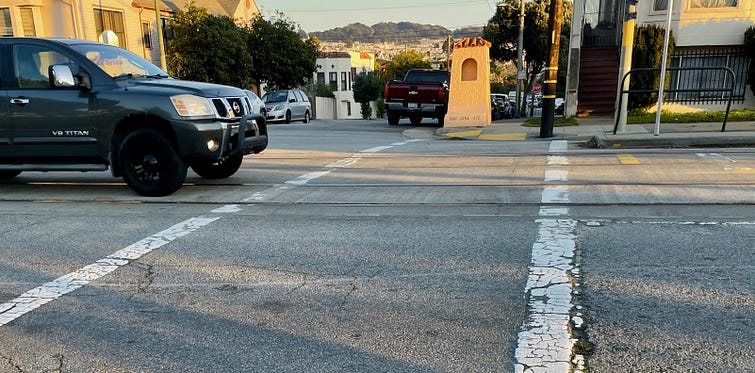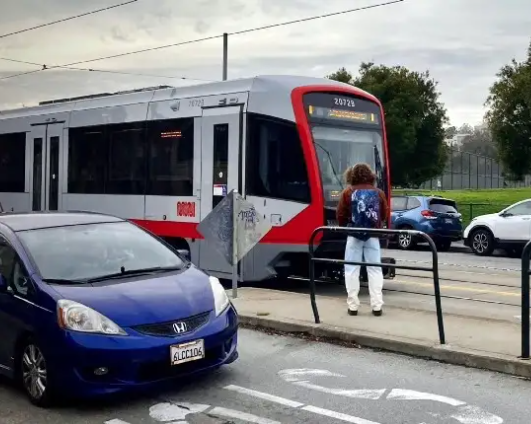The original version of this story appeared in The Frisc and is reprinted here with permission.
San Francisco’s decade-old campaign for safer streets is heading in the wrong and ever more dangerous direction.
In 2022, 37 people, including 19 pedestrians, were killed by drivers. It’s the highest tally since the city’s 2014 Vision Zero pledge, and it comes despite a high-profile program, touted by Mayor London Breed, to make improvements through “quick-build” fixes that are supposed to cut through bureaucratic red tape.
But there have been no significant quick-build improvements on Bay St. and Potrero Ave., scenes of the city’s two most recent fatalities, prompting Walk SF executive director Jodie Medeiros to criticize City Hall’s lack of progress. “The city is way behind on Vision Zero, and the list of streets they still need to address is not short,” Medeiros tells The Frisc.
San Francisco’s most dangerous streets make up the “high-injury network.” Another street in the network is a half-mile stretch of San Jose Ave. that’s dense with kids and families and borders Balboa Park. Residents there also feel a sense of urgency.
Since 2005, 99 people have been injured in crashes along this segment of the street — roughly one every two months — according to Department of Public Health data analyzed by Stephen Braitsch, founder and creative director of street safety nonprofit Transpo Maps. Braitsch cautions the number could be higher, because SF ramped up its record-keeping in 2014 as part of the Vision Zero program.
Miraculously, none of the 99 injuries Braitsch found have included pedestrian fatalities.
Balboa Park — sporting a playground, skate park, multiple recreation fields and courts, as well as a police station, indoor pool, and dog run — is a hive of activity, much of it kid-centered. Balboa High School, James Denman Middle School, and Peekaboo Childcare are nearby. The Balboa Upper Yard, a huge project with 131 new homes, will bring more park users, more riders of the J Church Muni line that runs along San Jose, along with more drivers. The Excelsior is getting denser, and Balboa Park is prime neighborhood green space.

Like Frogger, but it’s no game
Kate Levitt lives in the neighborhood, and crossing San Jose’s four lanes of traffic with a dog and third grader for soccer practices and playground visits requires strategy. “It’s like playing a game of Frogger,” she says. In addition, getting on and off J Church at the stops near her house means standing on narrow islands with flimsy guardrails that a small child can easily wiggle through and stumble into traffic.
Levitt, an SF native, grew up riding Muni and BART to Balboa Park for sports practices and remembers moving around town feeling easy when she was a teenager, a time in life when many feel invincible.
That sense of independence is tough to foster among younger children when crossing the street is precarious, says neighbor Shirin Keen. Keen and her family live on San Jose at San Juan, and her 7-year-old son’s best friend lives across the street. “We’d love to send our sons across the street themselves to meet, but it’s too scary,” she adds.
Levitt and Keen have joined longtime residents in the Mission Terrace neighborhood who have been asking for stop signs and other traffic calming measures along San Jose for more than 10 years, with little to show for it. There are traffic lights at the intersections of Ocean and Santa Rosa avenues, but along the half-mile in between, only one intersection has stop signs. All other crossings, including one closest to the children’s playground, have no stop signs.
Beyond adding lights or signs, the city has the Quick-Build program, which launched four years ago to bring about lower-cost safety measures on a faster timeline. Breed pledged in November 2021 to double down on Vision Zero and install traffic-calming fixes along the entire high-injury network by 2024, with 80 miles of corridor still needing work.
But as with Vision Zero itself — a promise of zero traffic deaths by next year — it will take a massive push to hit those goals. The amount of progress is a point of contention. The city’s latest Quick-Build project list showed only three of the 80 high-injury network miles completed last year, with plans to complete another 11.6 miles in 2023.
SFMTA, the city’s transit agency, disputes those numbers. Spokesman Steven Chun said there were improvements last year on 17 miles of high-injury network streets.
The city has also made safety changes at 398 high-injury network intersections, such as parking spaces that become red zones for better visibility, Chun said. (He also noted that safety fixes went into effect last year along 25 miles of streets not on the high injury network, thanks to projects such as the Van Ness Ave. rapid bus.)

‘Speeds in excess of 50 mph’
City planners have known about the San Jose Ave. issues for years. In a 2007 document titled San Jose Avenue Traffic Calming, SF Planning staff wrote that “vehicles continuing from the San Jose expressway enter the neighborhood at speeds often in excess of 50 mph.”
The “expressway” is a one-mile segment of San Jose connecting the neighborhood to the central part of the Mission District that has the look and feel of a freeway, with a posted 45 mph limit.
The document called for a host of interventions including bulb-outs, larger Muni islands, rumble strips, and planted medians to slow cars down and highlight crosswalks.
Nevertheless, the only change that came of that was a three-way stop sign at Santa Ynez Ave., at roughly the halfway point of the critical stretch of road, according to David Hooper, president of the New Mission Terrace Improvement Association and a retired cable car operator.
Today, the crosswalk at Santa Ynez looks worn, with cracked white paint and no signage warning drivers of a pedestrian crossing. The Muni islands remain narrow and ill-protected, and the streetlights are dim. If you’re driving west an hour or so before dusk, the sun can be blinding.

This dangerous combination leads to a lot of close calls, reports Maurice Rivers, who grew up and still lives in the neighborhood: “You have to make a conscious effort to cross the street, because cars don’t give any thought to stopping.”
There was another push in 2014 for improvements that went nowhere. The speed limit has since been lowered to 25 mph, but some drivers keep the pedal to the metal, says Rivers: “Cars feel emboldened to use the street as some sort of drag race until Ocean Ave.”
Now Rivers and Hooper are helping lead the latest charge, and the group has a comprehensive list of demands, such as highlighted crosswalks and radar speed signs. They brought their concerns to the SFMTA Citizens Advisory Council last fall, where over 60 people and local businesses such as neighborhood fixture Roxie Food Center made a plea for a safer San Jose. (SFMTA is in charge of Muni as well as streets.)
The council, in turn, took the concerns to SFMTA board members at the Oct. 18 meeting. After the presentation, SFMTA director Jeffrey Tumlin said his staff was working on solutions and hoped to present a plan in 2023.
SFMTA spokesman Chun, noting via email that the J Church adds complexity to the project, said, “We are committed to bringing safety, as well as transit reliability, improvements to the San Jose Ave. corridor in the near future.”
Cold comfort
The past few years have been dangerous for people on foot, and not just in San Francisco. Last May, the Governors Highway Safety Association reported that pedestrian deaths reached a 40-year high in 2021. SFMTA’s Chun said the “steady increase in antisocial driving behaviors” has contributed to the “devastating rise in fatalities” in 2022 — a third of SF traffic deaths were hit and runs, he said. “While we are doing everything we can to engineer the physical environment in a way that reduces the likelihood of crashes, we don’t have control over the way people are driving.”
Back on San Jose Ave., it’s cold comfort that none of the crashes have been fatal. Samuel Thomas, who recently moved to Mission Terrace, says he saw his 80-year-old neighbor taken away in an ambulance after trying to cross San Jose at Paulding and being struck by a vehicle. The intersection didn’t have a crosswalk at the time. The city added one after the collision, but there’s still no stop sign.
Thomas also says that his neighbor, who now requires round-the-clock care from a home health aide, still crosses the same intersection with help. Kids and families with strollers also have to cross, and drivers continue to blow through without stopping.
A father of two young children, Thomas is terrified that his kids or someone else’s will get rammed on their way to an after-school snack from Roxie, a swim class at the Balboa Pool, or just getting around the neighborhood.
“It’s terrible we don’t have basic design to protect children and families,” Thomas says.
***
Kristi Coale is a staff writer for The Frisc, covering transit, streets, and more.





